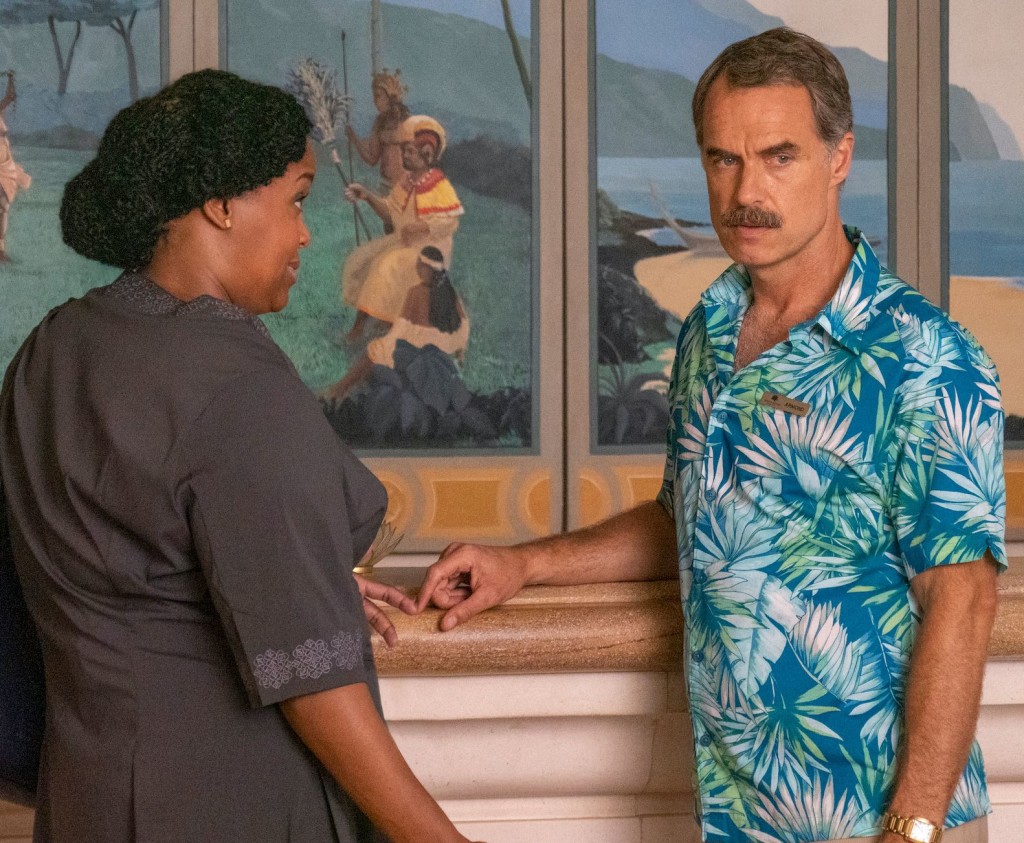It’s the LAST DAY of White Lotus Is Amazing Week. I know that some of you are going to go in a deep depression after this. Just know that there are outlets where you have support. White Lotus Discussion reddit threads. Youtube interviews with the cast and crew. I’ll be publicly recreating scenes from the show at Griffith Park this weekend for anyone who wants to stop by. Don’t worry, the Steve Zahn opeing shot will be censored. That was one of the first things the Los Angeles Public Parks Department demanded when I applied for the permit. But sadly, starting Tuesday, we’re going back to a White Lotus Free Zone. Feel free to pay your respects in the comments section.
Our final topic of discussion is going to be the intersection between plot and character.
One of the common criticisms I’ve been hearing from the WLHA (White Lotus Haterz Association) is that there’s nooooooo plooooootttttttt. Nothing happens! It’s just a bunch of characters walking around a beach doing nothing. What gives? How could anybody find that interesting?
It’s a good question. I agree that White Lotus doesn’t have a ton of plot. But I still think it’s exceptional. Why is that? And how can one write a show or a movie that’s light on plot and still good? I’ll answer that in a second. But first, let’s talk about what plot is because it’s often misunderstood.
Google defines plot as “the main events of a movie devised and presented by the writer as an interrelated sequence.” I’ve heard numerous variations of this definition, probably the most common being, “A series of connected events that happen one after another.”
But I don’t think that captures the full breadth of plot. When you’re talking about plot, there’s a creative component to the variables in the story that needs to be included. When George Lucas comes up with this idea that the Death Star is on its way to destroy the Rebel Base, there’s a lot of creativity that goes into that choice. The idea of a moon-sized base that can blow planets up may be more imagination than plotting. But the base has such an outsized influence on the story, dictating so many plot-threads, that it’s essentially part of the plotting.
I guess what I’m saying is, plot isn’t just the conveyor belt that moves the story along. It’s all the creative elements within the story that affect what’s happening.
I bring this up because, typically, if you’re writing something that’s character-based, it’s a good idea to throw in some creative plot elements to spike the story. Get Out is a good example. It’s a character piece but a lot of crazy things happen during the plot to spike it. Meanwhile, White Lotus doesn’t have many creative plot elements at all, which, I’m guessing, is why the WLHA are so underwhelmed.
They’re probably wondering why I like a show such as White Lotus when I’ve dinged so many screenplays before this for having little to no plot. A recent example is Dust, the script I reviewed last week about a woman stuck in her house during an extended dust storm. I hated that script mainly because NOTHING HAPPENED. So why does White Lotus get a pass and Dust doesn’t? Well, let’s find out.
When you write a character piece, you’re essentially wiping out the “EXTERNAL CONFLICT” portion of the plot (which I talked about yesterday). You’re taking out the killer tsunami. You’re eliminating the bank heist. Nobody’s asking you to jump into multi-verses to capture other versions of yourself. The big external conflict factor is eliminated in favor of internal and interpersonal conflict.
Our plot, then, is the unresolved conflicts *within* the characters as well as *between* the characters. Here’s how the formula works. The writer comes up with a group of characters. For each character, they make them either likable, sympathetic, or interesting. This is what “hooks” the reader. They either like, sympathize, or are intrigued by a character. They’re now invested in that character’s actions and want to see what happens to them.
From there, you figure out the internal conflict. Remember, the internal conflict in a character piece is going to become a plot thread. We don’t have Thanos threatening to kill anyone so the plot needs to come from the character. Mark (the father) learns from his uncle that *his* father, who died a long time ago, didn’t die from cancer like he was originally told, but rather from AIDS. Mark learns that his father was gay and used to sleep with men outside the marriage.
This becomes Mark’s internal struggle. Nothing about his childhood is real anymore. It’s all a lie. Which means Mark’s out of balance. He doesn’t know how to reconcile this new information. So this vacation is him trying to come to terms with this new information and figure out what it means for him as a father and as a husband.
Mark’s journey to find balance within himself is the PLOT of a character piece. As is Rachel’s (the young beautiful wife) journey to figure out if she wants to be a trophy wife for the rest of her life. As is Tanya’s (the older socialite) journey to move on from her mother’s death. As is Quinn’s (the 15 year old social anxiety-ridden son) journey to connect with the world for the first time, which is resolved when he joins the local rowing team.
Now, if you don’t like these characters, you’re not going to care whether they resolve these issues or not. You don’t have the flashy entertainment factor of a James Bond plot to fall back on. It’s just a bunch of unlikable people to you. That’s why you’re bored. But to those of us who like the characters, their journeys to either resolve or fail to resolve these issues is why we watch. We’re fascinated by these people so of course we want to know if they figure themselves out.
The second area where you create plot in a character piece is through unresolved relationships, which we talked about yesterday (interpersonal conflict). If you attempt to plot your movie solely through internal struggle, it’s not going to be enough. Even the most ardent cinephiles need something going on *outside* of the character to be interested. Which is why interpersonal conflicts become so important in a character piece. They’re your main plot engine.
Mike White knew this which is why he spent so much time on the relationships. Will Shane get the Pineapple Suite from Armond? Will Olivia and Paula get their drugs back from Armond? Will Rachel leave Shane? Will Mark and his son connect? Will Mark and Nicole fix their marriage? Will Belinda get the investment to start a new business from Tanya? What will Olivia do about Paula sneaking around behind her back?
To those of us who like these characters, we can’t wait to see how their conflicts are resolved. That’s what’s confusing to those who dislike the show. To them, they’re wondering, “Why do people like this? Nothing’s happening. There’s no plot.” Well, once we became hooked on these characters, their unresolved conflicts were enough of a plot for us. And that’s true for any story, which is why characters are so important. If you can create captivating characters, readers will follow them through weak plots, messy plots, plot-hole filled plots. Which is why I say characters are the most important element of any screenplay.
To summarize, if you create a character we’re interested in, give that character an internal unresolved struggle, then give them between 1-3 interpersonal unresolved conflicts with other characters, that can be enough to plot a story. You’re still on the hook to come up with twists and turns and interesting developments within the story – such as Shane’s mother showing up on the honeymoon – but if you get those three things right (character we like, compelling internal struggle, compelling interpersonal conflicts), you too can write a show as awesome as White Lotus.
And that concludes White Lotus Week. I hope you enjoyed it as much as I did. Monday is Labor Day so I’ll catch you back here on Tuesday!





